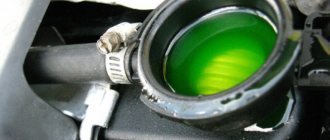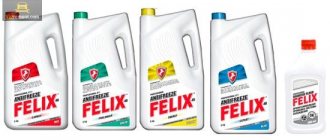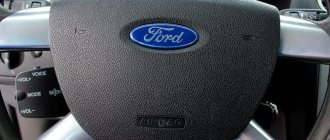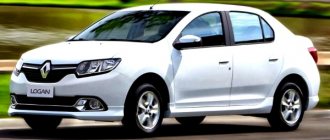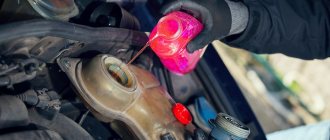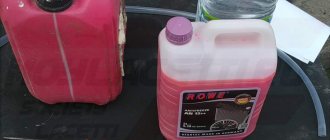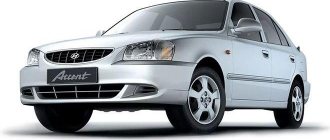A few quotes from a physics course
No, we will not sprinkle in formulas and laws, recall Carnot cycles and calculate efficiency using the ABC book. There is simply one figure that will convince even a camel that the coolant in the engine is no less important than engine oil.
If we take an average engine with a power of 100 kW, then according to all the laws of thermodynamics, this figure indicates the positive work that the motor transmits to the drive wheels. A modern tuned motor cannot produce more than 30% efficiency, hence the rated power of our motor is 333 kW. In other words, the engine burns just enough fuel to produce 333 kW. At the output we get only 100. Where the remaining 233 went is quite clear - they turned into heat. The enormous amount of heat that the coolant removes from the engine into the atmosphere.
Engine problems due to poor quality coolant
When it became clear how important antifreeze is for a car engine, let’s move on to the quality of coolants that are sold on store shelves. The main problem in choosing is not that the manufacturer himself indicates which antifreeze is best for a particular engine, but what quality of antifreeze we can buy. If the manufacturer states that you need to fill the Priora with Felix 40, and the VAZ 2114 with Cool Stream Standard, then you need to either adhere to the factory recommendations, or study the brands of antifreeze in detail in order to select replacements from another company that are exactly the same in composition. Otherwise problems are inevitable. And they can be expressed as follows:
- Engine overheating. Normal engine operating temperature is 80-90 degrees. If it rises by 3-5 degrees, the engine overheats, increased fuel consumption and a drop in power appear, and at 110 degrees aluminum alloys lose their properties.
- Corrosion. The most common defect caused by low-quality antifreeze. Antifreeze, not designed for use with any metal included in the system, inevitably causes corrosion and coking of channels, which, in turn, leads to overheating, deformation of oil scraper rings, and premature aging of the oil. Therefore, at the first signs of rust in the expansion tank, you need to immediately change the antifreeze.
- Cavitation. A very serious defect that can be caused by poor-quality antifreeze. The cavitation process is reminiscent of the collapse of bubbles of boiling water in a kettle, only in the limited space of the engine’s water jacket this leads to the washing out of metal particles from the cylinder block parts, up to the complete disappearance of the partitions and failure of the vane pumps.
Types of coolants
Absolutely all new coolants are produced from ethylene glycol, modifying additives and distilled water. 95% is water and ethylene glycol, and the rest is additives, which determine the brand of liquid, its anti-cavitation, anti-corrosion properties, price and service life. Any of the antifreezes are sold in the form of concentrates and ready-to-use liquids. The concentrate is convenient in that anyone can dilute it with water to the freezing point required in a particular region.
For our climate zone it is usually diluted in a 50/50 ratio. Finished coolants are marked by the manufacturer according to their freezing temperature.
All coolants are divided into four categories, depending on the additives used:
- Carboxylate antifreezes are considered the best in terms of service life and properties, and they are suitable for most modern engines. AvtoVAZ only began using these antifreezes in 2005, filling all cars leaving the assembly line with them. This group is distinguished from all other types of antifreeze by the absence of inorganic additives. On all assembly lines where Russian foreign cars are produced, only this type of antifreeze is used. It is easily recognized by the designation G12, G12+./li>
- Hybrid antifreezes also do their job well. They are designated on the packaging according to the VW G11 standard, and Japanese, American and Asian manufacturers - HOAT, NF, Hybrid Technology. These antifreezes are included in the mandatory first refueling program for BMW, Mercedes, and Chrysler.
- Lobrid antifreeze. Such liquids began to be produced after 2008. And according to VW specifications they are marked G12++, G13. They are distinguished from carboxylate coolants by the addition of inorganic substances, usually silicates. Such liquids have not yet been fully tested, and only time will tell how they will behave in the future.
- Traditional antifreezes - the inorganic technologies by which they were produced were hopelessly outdated back in the 90s, and today it is rare that any company is seriously involved in their production. It is precisely these suspicious mixtures that are sold to us under the guise of various “antifreezes”, painted in different colors. It can be blue, green or red, but using them is strictly not recommended. Color is just a dye, and it can be anything you want.
Lobrid antifreeze is a new trend in coolant, produced since 2008
Unscrupulous sellers take advantage of this, imposing a certified engine time bomb on naive buyers. Be careful when purchasing coolant so that your car's engine does not suffer from low-quality materials.
- News
- Workshop
Ban on hand-held traffic police radars: in some regions it has been lifted
Let us recall that the ban on hand-held radars for recording traffic violations (models “Sokol-Visa”, “Berkut-Visa”, “Vizir”, “Vizir-2M”, “Binar”, etc.) appeared after a letter from the head of the Ministry of Internal Affairs Vladimir Kolokoltsev about the need fight against corruption in the ranks of traffic police officers. The ban came into force on July 10, 2016 in many regions of the country. However, in Tatarstan traffic police inspectors...
Traffic jams in Moscow will be warned a week in advance
The center’s specialists took this measure because of work in the center of Moscow under the “My Street” program, reports the Official Portal of the Mayor and the Government of the capital. The data center is already analyzing traffic flows in the Central Administrative District. At the moment, there are difficulties on the roads in the center, including on Tverskaya Street, Boulevard and Garden Rings and Novy Arbat. The press service of the department...
Limousine for the President: more details revealed
The Federal Patent Service website continues to be the only open source of information about the “car for the president.” First, NAMI patented industrial models of two cars - a limousine and a crossover, which are part of the Cortege project. Then our people registered an industrial design called “Car Dashboard” (most likely...
Video of the day: electric car reaches 100 km/h in 1.5 seconds
The electric car, called Grimsel, was able to accelerate from zero to 100 km/h in 1.513 seconds. The achievement was recorded on the runway of the air base in Dübendorf. The Grimsel car is an experimental car developed by students from ETH Zurich and the Lucerne University of Applied Sciences. The car was created to participate...
AvtoVAZ nominated its own candidate to the State Duma
As stated in the official statement of AvtoVAZ, V. Derzhak worked for more than 27 years at the enterprise and went through all stages of career development - from an ordinary worker to a foreman. The initiative to nominate a representative of AvtoVAZ’s workforce to the State Duma belongs to the company’s staff and was announced on June 5 during the celebration of Tolyatti City Day. Initiative...
The iconic Toyota SUV will sink into oblivion
The complete cessation of production of the car, which until now was produced for the markets of Australia and the Middle East, is planned for August 2016, reports Motoring. The production Toyota FJ Cruiser was first shown in 2005 at the International Auto Show in New York. From the start of sales until today, the car was equipped with a four-liter petrol...
Suzuki SX4 has undergone restyling (photo)
From now on, in Europe, the car is offered only with turbocharged engines: liter gasoline (112 hp) and 1.4-liter (140 hp) units, as well as a 1.6-liter turbodiesel engine developing 120 horsepower. Before modernization, the car was also offered with a 1.6-liter 120-horsepower naturally aspirated gasoline engine, but in Russia this unit will be retained. In addition, after...
Dakar 2017 may take place without the KAMAZ-master team
The Russian KAMAZ-master team is currently one of the most powerful rally-raid teams on the planet: from 2013 to 2015, blue and white trucks took gold in the Dakar marathon three times, and this year the crew led by Airat Mardeev became second. However, as the director of NP KAMAZ-Avtosport Vladimir told the TASS agency...
In the Stavropol region, the use of hand-held radars was again allowed
The head of the State Traffic Safety Inspectorate for the Stavropol Territory, Alexey Safonov, spoke about this, RIA Novosti reports. The head of the local State Traffic Inspectorate said that during 1.5 hours of work, 30 speed limit violations were recorded. At the same time, those drivers are identified who exceed the permitted speed by 40 km/h and above. At the same time, Safonov proposed introducing criminal liability...
Mercedes will release a mini-Gelendevagen: new details
The new model, designed to become an alternative to the elegant Mercedes-Benz GLA, will receive a brutal appearance in the style of the Gelendevagen - Mercedes-Benz G-Class. The German publication Auto Bild managed to find out new details about this model. So, if you believe insider information, the Mercedes-Benz GLB will have an angular design. On the other hand, complete...
What car colors are the most popular?
Compared to reliability and technical characteristics, the color of a car’s body is, one might say, a trifle – but a trifle that is quite important. Once upon a time, the color range of vehicles was not particularly diverse, but these times have long since sunk into oblivion, and today motorists have a wide range of options at their disposal...
WHAT car to buy for a beginner, what car to buy.
Which car should a beginner buy? When the long-awaited driver's license is finally obtained, the most pleasant and exciting moment comes - buying a car. The auto industry is vying with each other to offer customers the most sophisticated new products, and it is very difficult for an inexperienced driver to make the right choice. But often it is from the first...
Using high-quality coolant in a car allows owners to get rid of the problem of engine overheating. Thanks to the refrigerant, heat from the engine is transferred to the environment and to the interior of the car. In what cases is it necessary to replace antifreeze on a Priora and how to perform this task yourself, we will tell you below.
[Hide]
Timing for coolant replacement
In VAZ Priora cars with a 16-valve engine manufactured in 2011 and other years of production, the frequency of antifreeze changes is 75 thousand kilometers. Then the working fluid begins to lose its properties. In addition, the refrigerant that is poured during production is changed every five years, if during this time the car has not traveled 75 thousand km. But this applies to the initial replacement of the fluid that is filled in from the factory. If you use regular antifreeze, then its service life is shorter and is about 30-40 thousand kilometers.
The need to change the working fluid can be determined by the following “symptoms”:
- the antifreeze has become dirtier, black, and traces of deposits have appeared in it;
- a refrigerant leak has occurred, as a result of which more liquid will need to be added to the system, and if you do not know what kind of antifreeze was added, then it will have to be changed;
- the presence of deposits and dirt in the expansion tank, this indicates that the substance has lost its properties;
- foam formation in the reservoir under the hood;
- the stove began to work worse in the winter season;
- the engine began to boil.
Video “How to drain the coolant on a Lada Priora car”
You can learn how to properly drain consumables from the video.
How much antifreeze should be poured into Priora
Many car owners are concerned about the amount of antifreeze in the Priora cooling system. what kind of antifreeze is recommended to be poured into the Opel Astra? To change the antifreeze,. According to the passport, it takes 7.84 liters, but many car enthusiasts claim that 6 liters is enough.
Cooling water tank
As water for cooling the Lada Priora, can be used as antifreeze
, and so is antifreeze.
According to the documentation, antifreeze is replaced every 75,000 kilometers or once every 5 years.
Replacing the coolant on the Lada Priora takes place in several steps, namely:
- Drain coolant from the system.
- Filling with the latest.
- Removal or expulsion of the so-called air lock or excess air.
Cooling system diagram
Coolant selection
The manufacturer decided that the best way to cool the power unit is with red Felix-40 antifreeze. Cool Stream Standard 40 refrigerant can also be used. You can find out in more detail what is in your car by looking at the sticker on the expansion tank in the engine compartment.
In accordance with the official guidelines, any brand of liquid can be used. The main thing is that you need to pour in those refrigerants that meet the standards of antifreeze poured during production.
What antifreeze does AvtoVAZ recommend?
For all VAZ engines (Lada Granta, Kalina, Priora, Niva 4x4), the manufacturer’s recommendations are the same (data from books on the operation, maintenance and repair of Lada cars):
- Antifreeze G-48;
- Cool Steam Standard;
- Cool Steam Premium;
- TS-Felix;
- Felix Carbox;
- SINTEC (for example, “Antifreeze SINTEC” TU 2422-047-51140047-2007);
- Long Life;
- G-Energy Antefreexe.
For K4M and K7M power units that are installed on Lada Largus, the manufacturer recommends GLACOEL RX antifreeze (type D). For Lada Vesta and XRAY, it is recommended to use Type D antifreeze based on a mixture of water and ethylene glycol.
Level control and how many liters are needed
To understand how many liters of refrigerant need to be poured into the Priora 16 valves, refer to the car’s operating instructions. The technical manual states that the cooling system capacity is 7.8 liters. Therefore, exactly the same amount of refrigerant is poured into it.
The Prio Dvenar channel published a video in which it showed how the procedure for replacing the coolant in Priora is carried out.
Fluid level diagnostics must be performed on a cold engine. Open the hood and locate the antifreeze expansion tank. You will see two marks on the tank - MIN and MAX, the volume of liquid should be normal between them. If there are no marks on the tank, then it has a horizontal edge that shows the normal level of antifreeze. In order for the system to effectively cool the power unit, it must not be filled with less than the required amount of refrigerant.
Why is it flowing?
If the level of antifreeze in the coolant reservoir continuously decreases, then it is likely that there is a leak in the cooling system. In this case, you need to inspect the entire cooling system, find and repair the damage.
Examine the components and assemblies under the hood, and first of all the condition:
If all connections are in order, then one of the nodes may be faulty, namely:
- coolant tank housing;
- engine radiator;
- heating radiator;
- thermostat;
- connections between the coolant pump (pump) and the cylinder block.
We also look for coolant leaks from the pump drain hole as a result of oil seal wear.
We monitor the antifreeze temperature using the indicator on the sensor.
How to change it correctly?
Next, we will look at how to correctly replace the working fluid of the cooling system in a Lada Priora car with an electronic pedal or with air conditioning. You can change the refrigerant at a service station, but this task is quite simple and anyone can handle it on their own. For the best effect it is necessary, we will talk about this below.
Preparation
Before you begin the process, prepare the following:
- fresh refrigerant in the required volume;
- seal for the drain cover if the old one is worn out;
- set of wrenches;
- clean rags;
- container for collecting used antifreeze.
The Lada Priora Repair and Maintenance channel provided a video that demonstrated the procedure for draining the working fluid from the cooling system.
Step-by-step instruction
How to replace antifreeze on a Priora:
- Drive the car into a garage with a pit; you will need a flat surface to perform the work. Wait until the engine cools down; the entire process is carried out cold.
- There should not be high pressure in the cooling system. To reset it, open the hood and unscrew the expansion tank cap. If the engine is hot, coolant may spray out of the hole, so use a rag when opening it.
- Dismantle the plastic protection of the power unit. To remove it you need to unscrew two fasteners on the sides. It is not necessary to dismantle the clamps, but removing them will make the task more convenient.
- If your car is equipped with a transmission with control cables, then it is necessary to dismantle the starter device. To do this, disconnect the negative terminal from the car battery. Press the fastening of the connector with the wiring and disconnect the plug from the output of the traction relay. Remove the protective cap from the nut securing the tip of the wire connected to the positive terminal of the battery. Using a 13mm wrench, unscrew the nut and remove the cable tip from the contact screw on the traction relay. Then use the same tool to unscrew the screws and dismantle the starter device. If the car's transmission is controlled by traction, then there is no need to dismantle the starter.
- Find the drain plug; it is located directly on the cylinder block. You need to place an old bucket or basin under it, into which the used refrigerant will be drained. Unscrew the cap and wait until the liquid comes out of the system. Also unscrew the protective valve under the radiator device; some of the substance will also flow out of it. When the draining is complete, you need to tighten both plugs. Don't forget to check the condition of the seal on the drain cap. If it is worn out or there are traces of defects, the ring must be replaced.
- Assess the condition of the refrigerant drained from the refrigeration system. If there are traces of deposits, wear products, or the liquid as a whole is very cloudy and viscous, it is recommended to flush all components. To do this, pour about 7.8 liters of distilled water into the system through the expansion tank. You can add vinegar or citric acid to it to remove dirt. The use of special cleaning agents is allowed. After filling, the engine starts, you can perform a test drive. Then the procedure for draining the refrigerant from the power unit is repeated. If the liquid is still dirty, then the washing is repeated until it comes out clear.
- Assess the condition of all pipes and lines of the cooling system. If there is damage or signs of leaks, the hoses must be replaced.
- The next step is to pour new refrigerant into the system. To prevent an air lock from appearing in the lines and eliminate air entering the system, it is recommended to slightly loosen the clamp of the pipe connected to the throttle assembly. The hose is then disconnected.
- The cooling system is filled with fresh antifreeze through the filler neck in the expansion tank. New refrigerant is poured in until it comes out of the pipe disconnected from the throttle. When this happens, the line is connected into place and the clamp is securely tightened. Then the refrigerant is added to the system to the required level.
- All previously dismantled components are reassembled in reverse order.
- The engine starts and the journey is carried out. Now you need to once again make sure that the fluid level is correct. Make sure there is no leakage from the drain hole.
Remove the cover on the expansion tank Unscrew the drain valve on the radiator cooling device of the engine Remove the starter from the car by disconnecting all fasteners
Selection and replacement of antifreeze in Priora
Replacing the cooling fluid is a responsible task. Before starting the procedure, you should study the operating rules in detail so as not to get burned. Antifreeze for Priora is poured at certain intervals, observing the standards. It is recommended to replace it every sixty thousand kilometers. Some people prefer to do this once every two years.
- How many liters of antifreeze are in Priora?
- When should you replace?
- How to choose a coolant?
- How to check the fluid level and how much will be enough?
- How to replace?
- Preparatory stage
- Algorithm of actions
- Why is liquid leaking out?
- What happens if it is too late to replace?
- Cost of liquid
- We recommend watching:
How many liters of antifreeze are in Priora?
It is believed that cooling liquid must be poured into a Priora 16 with a valve system every five years. It is designed to reduce the engine temperature while driving to avoid overheating.
It is worth replacing on time. If this is not done, antifreeze decomposition products will be deposited on the metal parts of the engine. They are incompatible with the operation of the structure. The device runs the risk of wearing out in a short period of time. It is also possible that the cooling fluid may overheat. The consequences of this can be unpleasant:
- reduction in engine power;
- reduction in equipment service life;
- high fuel consumption.
This is possible due to the formation of corrosion in the engine, as well as the narrowing of the tubes through which the fuel passes. Due to the fact that the engine constantly operates at elevated temperatures, the channels are deformed. Fuel and lubricating oil liquids are mixed. This leads to system wear and failure.
Bubbles may form in the container containing the coolant. In winter, cracks may form in the tank, which will require a complete replacement of the motor and other damaged parts.
Untimely replacement of antifreeze leads to many unpleasant consequences. Check periodically. If, when opening the lid, you notice an uncharacteristic color or consistency of the liquid, it is recommended to replace it immediately.
When should you replace?
The frequency of fluid replacement in Priora models that were released after 2011 is approximately seventy-five thousand kilometers. After this period, antifreeze loses its functional properties. This is only true for the product provided by the original manufacturer. If you use Antifreeze, it will last half as long.
The need to replace the coolant can be determined by the following symptoms:
- the appearance of dirt, uncharacteristic marks, lumps of thickened liquid;
- antifreeze has begun to leak out - it can be replenished, but if you do not know the exact brand, it is recommended to replace it;
- there are deposits and dirty traces in the container, which indicates the need for an urgent replacement of the fluid, which has lost its performance properties;
- under the hood foam appears in the reservoir intended for storing fluid;
- reduction in the quality of operation of the air heating stove;
- The motor heats up at a high speed.
How to choose a coolant?
Answering the question of what antifreeze to use in Priora, the manufacturer did not provide a large assortment to its users. It is best to use the Felix-40 cooler. You can use other brands, but this is not recommended. The engine system may wear out in a shorter period of time. As a result, you will have to contact the service for global repairs and replacement of parts.
To find out what kind of antifreeze your car uses, look under the hood. There should be a barrel with a sticker next to the fuel compartment.
If you are using antifreeze from another manufacturer, it is recommended to study its characteristics. It must meet international quality standards.
How to check the fluid level and how much will be enough?
To determine how many liters of coolant are needed to fill the tank, carefully read the vehicle's owner's manual. You will need approximately 7.8 liters. Some car owners prefer to fill a little less - 6 liters.
You can check the antifreeze level in the tank even on a cold engine. To do this, lift the hood lid. You will see a tank. There are two marks on it with a maximum and a minimum value. The fluid level must be within these marks.
If there are no recognition symbols on the tank itself, look for them nearby. There should be a scale that indicates how much antifreeze is in the tank on a Priora with 16 valves. For the engine to operate properly, the level of cooling fluid must remain stable.
How to replace?
The work process is quite simple, so every car owner must be able to carry out the replacement. You can also contact the service if necessary. For the procedure to be most effective, it is recommended to flush the entire system, which will be discussed below.
Preparatory stage
Before you start, you should do the following:
- choose and buy a suitable cooler;
- stock up on a new cover mount in case the old one is damaged;
- take the wrench;
- find a container where you will send the waste liquid;
- buy rags.
Algorithm of actions
To replace antifreeze in Priora, follow the instructions:
- Send the car to a garage with plenty of free space to work on. Cool down the engine. All actions must be performed on a cold engine system.
- Get rid of high blood pressure. Open the cap of the reservoir containing the antifreeze. If the engine is hot, fluid may splash out. Use a cloth and gloves for protection.
- Remove the protection that is installed on the propulsion system. Unscrew the bolts on the mount. The latches do not need to be removed. They will not interfere with the process.
- If a transmission with cables is installed, it must be removed. To do this, disconnect power from the battery. Remove the protective coating with a wrench.
- Now you need to drain the entire volume of liquid. To do this, unscrew the fixing cap. Place a container below where the waste material will be drained. Wait until all the refrigerant has left the tank. Assess the condition of the latch. If signs of wear are noticeable, replacement is recommended.
- If there are any cloudy traces in the coolant, it is recommended to flush all the channels in the car. To do this, add purified water. Add citric acid or vinegar to remove any remaining dirt. Flush the system until the water runs clear. Only after this can you fill the coolant into the tank.
- Assess the condition of the hoses. If they are worn out, replace them.
- Using a hose, pour new fluid into the container. Avoid high internal pressure.
- Refrigerant is added until the tank is filled to the optimum level.
- All disassembled parts are reassembled in reverse order.
- Start the engine and take it for a test drive. After this, check if all systems are normal.
Why is liquid leaking out?
If there is a constant decrease in the level of antifreeze in the tank, then there is a leak somewhere. Every detail must be examined to quickly identify and repair damage.
What happens if it is too late to replace?
Coolant loses its properties over time. Every year the cooling system will work worse and worse. If you do not change antifreeze on time, you risk the following:
- The engine will heat up faster. If it constantly operates at elevated temperatures, the system risks breaking down quickly.
- The liquid will freeze in the tank. As a result, you will not be able to start your car in winter.
- Blood pressure may increase. Because of this, antifreeze will begin to leak.
Cost of liquid
The liquid costs about one hundred and fifty rubles per liter. To completely fill the tank, you will need to spend nine hundred rubles. When washing, you should buy purified water in advance.
Consequences of untimely replacement
Over time, the refrigerant loses its original characteristics, as a result of which it will not be able to effectively cool the power unit.
If the antifreeze is not changed on time, this is fraught with serious problems:
- The engine will heat up faster, and regular operation of the machine with an overheated engine can lead to its complete failure.
- The working fluid in the cooling system will freeze and it will be impossible to start the internal combustion engine in the cold season.
- The pressure in the lines may increase. Because of this, the oil seals and seals will be squeezed out, resulting in a refrigerant leak.
When to replace?
The manufacturer recommends changing the standard coolant after 75,000 km or 5 years of vehicle operation. These figures are typical only for a new car, since all SOD parts are new without traces of oxidation or rust. If the car was purchased on the secondary market, it is recommended to replace it with flushing the system immediately after its purchase. And subsequently change the antifreeze every 50,000 km or 3 years of operation.
An example of old antifreeze with rust
If the Priora was filled with antifreeze for some unknown reason, then it should be replaced with antifreeze. Antifreeze has more active chemicals that over time react with aluminum, thereby damaging the thermostat or pump.
Price issue
The cost of one liter of Felix antifreeze today is about 150 rubles. The price of Coolstream refrigerant is approximately the same. A complete replacement will require eight liters, so the cost of changing the coolant is about 900 rubles. If you are rinsing, you will also need to purchase distilled water.
Coolant (antifreeze), designed to lower the temperature of an engine that heats up during operation, needs to be replaced, like any other operating fluid. In a Lada Priora car, it indicates the need to replace antifreeze every 75,000 kilometers or once every five years (whichever happens first).
You should replace the coolant in a timely manner - otherwise you risk the fact that the additives added to the antifreeze may wear out and fall out as deposits that settle on the metal elements of the engine and the cooling path. They are aggressive towards the parts described above, accelerating their wear. In addition, in this case, there is a possibility of encountering overheating of the coolant, which entails a loss of power, increased fuel consumption and a reduction in engine life by 2-3 times. This occurs due to the formation of corrosion on the internal surfaces of the engine, narrowing of the radiator channels (and, therefore, a decrease in the coolant circulation rate). And continuous operation of the engine in overheating mode leads to deformation of the cylinder oil scraper rings, which entails mixing of exhaust gases and oil.
In addition, cavitation erosion (bubbles in the coolant) and the formation of silicate sediment are possible. In winter, a worn-out cooling system can contribute to the formation of cracks in the expansion tank.
As you can see, untimely replacement of antifreeze leads to serious wear of both the entire cooling system and engine elements. Therefore, you should periodically monitor the coolant level and check it. If you unscrew the reservoir cap and see that the antifreeze has faded, lost color or become cloudy brownish, you should replace it as soon as possible.
A more or less decent auto repair shop will charge you at least 800 rubles for replacing antifreeze. (prices from an official dealer are even higher). Not all services clean the cooling system; on average, the cost of this procedure ranges from 1,300 to 2,500 rubles. You can save a lot of money by replacing and cleaning it yourself. This will not require extra effort, and you will gain good experience.
Also, do not forget to purchase a new antifreeze canister (about 1,200 rubles for a 5-liter canister) and an expansion tank cap (its price is around 100 rubles).
The following equipment and materials will be required:
- Actually, antifreeze (8 liters)
- Screwdriver (preferably Phillips)
- Wide funnel attached to hose
- Distilled water (15 liters)
- Bottle brush
- Key diameter 13 mm.
- Citric acid or similar cleanser (2 sachets)
- Expansion tank cap
- Bucket or other container (volume of at least 8 liters), preferably 2 pcs.
We collect everything you need nearby so that it is at hand:
After this, it is necessary to remove the engine crankcase protection. Without performing this procedure, it is possible to remove spent coolant from the radiator cavity, but not from the BC.
First, place a container for old antifreeze under the drain hole.
Important: there is no need to unscrew the cap of the expansion tank, otherwise antifreeze will violently begin to pour out around the sides.
Unscrew the bolt plug of the drain hole on the BC, drain the waste liquid into a container:
If, after unscrewing the drain cap, antifreeze does not flow out, then a plug of dirt has formed near the drain hole, which can simply be loosened with a screwdriver.
Then you need to unscrew the cap of the expansion tank (this is necessary to equalize the pressure). Then you will need to drain the antifreeze from the radiator. To avoid accidentally hitting the generator, you can wrap it in a plastic bag or wrap it in a rag.
We find the valve, which is located at the bottom of the radiator, on the right, in front of the radiator. We place an empty container under this valve.
The valve should be unscrewed carefully, as the pressure of the coolant can be strong:
The more antifreeze is poured out, the more the valve should be unscrewed. Attention: there is a rubber seal on the valve, it is important not to lose it.
As soon as antifreeze stops flowing from both drain holes, you will need to screw the drain plug on the cylinder block and tighten the radiator valve.
It is necessary to pay attention to the color of the waste liquid. If it is not very cloudy, the cooling system can be cleaned using only distilled water. If there are various floating substances, etc., in the coolant, you will need to add citric acid (1 sachet) to distilled water.
Before you begin cleaning the cooling system, you will need to remove any air pockets in the circuit.
To do this, you will need to remove the hose from the heating fitting of the throttle assembly:
Only after this can you pour water diluted with acid into the removed pipe using a pre-prepared hose with a funnel. As soon as water begins to flow from the removed pipe, stop adding coolant. Do not close the expansion tank cap yet.
Then you will need to insert the hose into the fitting and start the engine (with the neck of the expansion tank open - this is required to better clean the circuit from air pockets). Wait 5-10 minutes, then turn off the engine. After this, you will need to drain the water using the method described above.
If the used cleaning fluid does not contain suspended matter or other substances, you can begin cleaning the expansion tank. If any sediment or impurities are clearly visible in the liquid, repeat the cleaning procedure with distilled water and acid again.
Don't forget to put the drain plug back in place:
Antifreeze is replaced in Lada Priora cars every 75,000 km, or after 5 years of operation. It all depends on which limit comes faster. A second replacement is required after 40,000 km, or two years. During maintenance, monitor the color of the coolant. If it changes color to a reddish color, replace the antifreeze, because this indicates a deterioration in the quality of additives and coolant characteristics.
What antifreeze is better to pour into Priora
The car's cooling system requires 7.84 liters of antifreeze, which is worth considering before replacing. For all engines of VAZ cars, including Lada Priora, the use of the following antifreezes is recommended:
- TC-Felix.
- Cool Stream Standard or Premium.
- G-Energy Antefreeze.
- Syntek.
- Antifreeze G-48 and others.
Replacement process
To change antifreeze on a VAZ 2170, prepare the necessary tool - a Phillips screwdriver, the required volume of coolant (buy one 10 liter canister or two 5 liter canisters), a key for “thirteen”, an empty container for draining the old fluid, as well as a clean rag.
Antifreeze drain
Before draining antifreeze from the system, place the car on a lift or inspection hole. Then proceed like this:
- Open the expansion tank.
- Remove the mudguard from the engine. If you don’t want to remove the protection, you don’t have to do this. But in such a situation, it is worth taking a number of actions to avoid drips. If nothing is done, then, during the draining process, the liquid will hit the crankcase protection and splash around.
- Place an empty container under the engine in a place where the old antifreeze will approximately drain.
- Open the drain hole on the cylinder block. As soon as the coolant is drained, wipe any marks from the engine surface.
- Place the container under the radiator, then open the drain hole (at the bottom of the radiator).
- Wait until the coolant is completely out of the system.
Remember that the cooling system fluid is extremely toxic. Before draining the antifreeze, prepare a special funnel and use it while draining the coolant from the crankcase and radiator. You can make such a funnel yourself by cutting off the wide part of a plastic bottle.
When removing the plug from the drain hole, be careful. There is a rubber ring installed on it that must be preserved. If there is damage (defects or tears), replace the part.
Filling with new antifreeze
The next stage of replacing antifreeze is filling the cooling system of the Lada Priora. Proceed like this:
- Screw the plug into the radiator and cylinder block.
- Loosen the compression of the clamp, then discard the tube to drain the coolant from the throttle heating fitting. This is required so that, during the process of filling the system, foreign air is gradually removed from it. If this work is not done, then there is a high risk of air locks forming, due to which the system itself will not be completely filled.
- Pour coolant into the reservoir until antifreeze runs out of the tube thrown away from the throttle assembly. As soon as this happens, put the hose in place and install the mounting clamp.
- During the filling process, monitor the volume of coolant in the system. As soon as the working composition reaches the MAX mark (marked on the wall of the expansion tank), stop filling.
Please note that after starting the engine, the antifreeze in the system must release excess air, which will cause the level of the working fluid to drop. At this point, the antifreeze replacement is almost complete. Screw the cap onto the expansion tank tightly. This is important because the coolant is under pressure in the system. If you tighten the cap with little force, a leak may occur.
Now start the engine. Allow it to reach operating temperature until the fan mounted on the radiator activates. As soon as this happens, turn off the engine and check the coolant level again. If necessary, top it up to the required level.
How to remove air from the system
If, after replacing the antifreeze, you notice that the cooling system of the Lada Priora is malfunctioning, the cause may be the presence of an air lock. There are two ways to remove it.
- Option #1. To remove air from the system, loosen the clamp and remove the heating pipe from the throttle assembly. Now unscrew the reservoir cap, cover it with a clean rag and blow into the neck until antifreeze comes out of the discarded tube. As soon as this happens, install the pipe in its original place and tighten the clamp with the required force.
- Option #2. If the option discussed above does not produce results, go another way. Start the engine and let it run to increase the pressure in the cooling system. Now turn off the engine and, without removing the cap from the coolant tank, discard the pipe from the throttle heating. Keep an eye on the tube. As soon as antifreeze begins to come out of it, return the pipe to its place and tighten the hose using a clamp.
When performing the work mentioned, be careful, because the antifreeze in the system may have a high temperature. To avoid the appearance of air locks in the system, during the process of replacing the coolant on the Lada Priora, from time to time, press on the radiator hoses.
If, after replacing the antifreeze, the coolant level constantly decreases, check the condition of the pipes and hose of the cooling system, the quality of their connections, as well as the integrity of the most important components, such as the radiator, reservoir housing and thermostat.
After 5-7 days, check its condition. If the antifreeze has changed color and turned brown, this indicates that a fake has been poured into the system, without corrosion inhibitors. High quality coolant will only darken slightly over time. If you find counterfeit fluid in the cooling system, replace it.
Above we discussed how to drain antifreeze, fill in new coolant and remove plugs from the cooling system in Lada Priora cars. Having such knowledge allows you to independently replace the working fluid and save money on visiting a service station.
Video: How to drain antifreeze on a Priora
If the video does not show, refresh the page or
In 2007, budget LADA Priora cars produced by the automobile manufacturer rolled off the production lines. Today there are different versions of this car with increased comfort and new functions. Antifreeze replacement on Priora should occur every seventy-five thousand kilometers.
It is very important to choose the right liquid
, which will fit this car, and then for a long time there will be no comments or complaints.
Lada Priora
- a machine that is quite unpretentious in maintenance, with a good and reliable engine, resistant to corrosion. Manufacturers managed to remove all design flaws, improve safety, modernize the car's driving performance and improve sound insulation.
What antifreeze to use:
- cool steam standard;
- cool steam premium;
- felix carbox;
- syntek;
- long life;
- energy
If antifreeze leaks on a Priora, you need to find out the problems and causes of the leak. If antifreeze escapes through the connections, this can be corrected by tightening the clamps. You can also install an additional clamp or replace the old one. If the pump fails, diagnosis is necessary by removing the belt cover. If it goes into the oil system, the oil level rises and repairs are necessary. And when it goes into the cylinders, steam appears from the exhaust pipe, which also leads to repairs.
You also need to know how to drain antifreeze from a Priora, observing the necessary conditions. Then it will be easy and feasible for any driver to do. Extreme caution and coordinated actions in the process of such work are recommended.
Replacing the fluid yourself:
- drain antifreeze from the system;
- add new fluid;
- remove air.
Coolant quantity – 7.82 liters
as directed by technical support for normal cooling operation. In some cases, six liters of antifreeze will be enough.
After installing the machine on a flat surface, it takes time for the engine to cool down. Then you need to remove the plastic protection by unscrewing the two fixing clips on the sides and unscrew the cap on the expansion tank. Place a container under the vehicle and drain the liquid by unscrewing the cap on the cylinder block. We also unscrew the protective plug under the radiator and the antifreeze flows out. An important recommendation is to close the existing plugs when the drainage is complete, and you can begin to replace the substance.
After replacing antifreeze on a Priora, you don’t have to worry that the car’s engine will overheat.
On a Priora, the coolant temperature sensor is located between the cylinder head and the thermostat
. It determines the temperature state of the engine, has two contacts, and practically does not break. The only negative is that the wires at the base of the connector often fray.
What kind of oil to fill in the power steering Priora
Thanks to the abundant distribution of domestic cars, drivers are constantly faced with their maintenance and repair. A popular question is what kind of oil to fill in the Priora power steering, when the procedure needs to be performed and how to properly service the car, we will deal with this.
Manufacturer's recommendations
Regarding compliance with standards and the availability of analogues of liquids, the company has strict recommendations. The manufacturer for Priora power steering recommends using exclusively the Pentosin Hydraulic Fluid CHF 11S formula.
According to the manuals and technical documentation, the mixture 100% satisfies the requirements of the mechanism, ensuring its full protection and long-term operation.
At the same time, the manufacturer’s requirements are relevant for all assemblies and years of production of the VAZ 2172.
What do motorists use?
Motorists often refuse to use the original product recommended by the factory. This is explained by the lack of oil in some regions and its high cost. In principle, this is possible. The mixture is often imported in small quantities and quickly sold out, which creates some difficulties.
To replace, motorists use similar mixtures from other manufacturers. An example is the popular product MANNOL 8990 Central Hydraulic Fluid.
What experienced experts say
Despite the contradictions, experienced craftsmen recommend adhering to the factory’s recommendations. A steering column is installed on the car. Trademark mechanisms can only be serviced with Pentosin liquids. Other brands do not have approvals.
How often to change oil in Priora power steering
According to the company's recommendations, the service interval for servicing a car's steering mechanism is 80,000 kilometers, or 5 years of continuous operation.
Factory parameters are a little out of touch with reality. “Impacted” domestic roads wear out the steering fluid much faster than stated. Drivers have experimentally established that already at 50,000 km, the fluid wears out to the limit. For this reason, the actual interval will be one third shorter.
How much oil to fill in Priora power steering
The total volume of the power steering system is 0.7 liters. Drivers usually purchase a liter canister. The remains are used for their intended purpose, or find third-party applications.
How to change oil in power steering VAZ 2172
To perform the procedure correctly, the sequence of actions must be followed.
- Drive the car for several kilometers to fully warm up the working mixture. This will allow the liquid to drain out of the module as much as possible.
- Place a container of at least 1 liter in volume under the drain hole of the system.
- Unscrew the drain plug and wait for the grease to drain.
- Tighten the drain hole and wipe off the remaining mixture with a rag.
- Pour fresh oil into the expansion tank to the maximum mark.
- Turn the steering wheel without starting the engine 5-6 times until it stops in both directions. At the same time, new fluid will flow through the line, squeezing out the air.
- Inspect the power steering unit and, if necessary, top up the power steering to the maximum and repeat the procedure.
- Next, you will need to start the power plant for 10 seconds to equalize the pressure in the lines.
After completing the operation, the system is considered pumped and ready for further operation.
Video
It turns out that the question of what oil to fill in the Priora power steering is quite simple when examined in detail. It is enough to follow the manufacturer’s requirements and use proprietary mixtures.
Mixing antifreeze
Antifreeze from different manufacturers cannot be mixed. When mixing liquids of different colors, many believe that nothing bad will happen. Various dyes are added to antifreeze to give it a tint, but it has no effect on the properties. Therefore, the choice of antifreeze should not be based on color, but on the chemical composition
(type) recommended by the car manufacturer. When the liquid is highly concentrated, it must be diluted with distilled water in the correct proportions.
On a Lada Priora car, antifreeze is replaced once every five years, and antifreeze - once every two years or after forty thousand kilometers. You need to buy coolant only of good quality and after measuring the density with a hydrometer. When mixing carboxylate and traditional additives, it is important to be aware that their chemicals will produce sediment. This leads to clogging of the cooling system itself.
An important element of the system is a liquid pump (pump), the purpose of which is to ensure the circulation of antifreeze. The condition of the pump should be checked frequently. If the bearing begins to fail, it will jam. As a result, it will become impossible to maintain the optimal temperature and there will be a risk of the drive belt breaking.
Before replacing the pump, you must prepare:
- container for draining;
- keys for dismantling;
- new water pump;
- sealant;
- inspection hole.
Priora 2014 is now available in three different variations: Standard, Normal and Lux. Its advantages are enhanced anti-corrosion protection using galvanization and a six-year warranty against through corrosion for any type of body. also installed in a number of trim levels.
, heated windows and seats, light and rain sensor. High-level security, equipped with the latest technologies.
Maintenance of VAZ-2110: what is better to fill with antifreeze or antifreeze
Now many car owners do not want to pour the usual antifreeze into the cooling system, since its characteristics are much lower than those of modern antifreezes. The debate about which of these liquids is better has not subsided for many years. If you want to know what is better to pour into the cooling system - antifreeze or antifreeze - it is worth studying in more detail the properties of each of these liquids.
What are coolants?
“Anti-freeze” is necessary for effective engine cooling. They must have the highest boiling point, since in the summer the engine often overheats. In addition, in most of our country, in winter the temperature drops to critical levels; in order for the cooling system to function normally, you need to take liquid with a freezing threshold at the lowest possible temperatures, this is especially important in Siberia and the northern territories.
Antifreeze and antifreeze have the same base - ethylene glycol mixed with distilled water. In its natural form, this alcohol boils at a temperature of 196 degrees and freezes at -11. When mixed with distilled water, you can increase the freezing threshold to -35, or even -65. This is enough to use liquids in the cooling system throughout Russia.
To increase the effectiveness of anti-freeze agents, additives are added to them, which perform another important function - they help protect pipes, tubes, radiator and engine block from the aggressive effects of liquid. If you pour a composition of two components (ethylene glycol and distilled water) into the system, then in the next month you will have to change the entire cooling system and even repair the engine. Thanks to additives, which occupy up to 20% of the volume of any antifreeze, the composition becomes more perfect.
Antifreeze
This blue liquid is known to all Soviet car enthusiasts. It is most often used on domestic cars and is nothing more than antifreeze, which uses traditional additives. Everyone thinks that this liquid comes in only one color, but there are two options for antifreeze:
- blue with a freezing threshold of about -30;
- red (pink) with operating temperature up to -50.
Chemical additives help the fluid form thin films on surfaces. With whom she comes into contact.
The advantages of antifreeze include its low price and popularity on domestic cars (many units work with it without failures, including the VAZ-2110).
At the same time, the classic “anti-freeze” has several disadvantages:
- impossibility of use on high-temperature engines (boils at 110 degrees);
- the need to change antifreeze after two to three years;
- high activity of the composition.
Domestic cars for the most part work properly on it, but foreign cars (especially new ones with composition sensors) may not even start if you put traditional antifreeze in the tank.
G11 – green antifreeze
At the beginning, it is worth noting that not only green-colored liquids are produced with the “G11” marking, they can be painted blue or even yellow, but recently manufacturers most often produce antifreeze of a grassy color. It copes well with small pockets of corrosion, which are neutralized with the help of additives.
In terms of its properties, G11 can be equated to antifreeze. It has one more small drawback - over time, the deposited additives begin to crumble and clog the small channels of the cooling system. The film that forms on the walls of the components reduces the heat removal from the engine, which has a more detrimental effect on it.
G12 – red antifreeze
This “anti-freeze” product uses fewer chemical additives; when modernizing the composition, manufacturers replaced them with organic ones (mainly carboxylic acid). Their main advantage is that a protective film is not formed and, accordingly, heat removal is not impaired. This antifreeze has improved characteristics:
- heat is removed more efficiently;
- there are no deposits on the walls of the system, therefore nothing crumbles;
- long service life - up to 60 months;
- The liquid fights corrosion areas.
With all these advantages, the G12 has one significant drawback - during its use, automatic maintenance of the cooling system is not carried out. This antifreeze best protects systems in which parts are made of brass and copper, but it does not have a pronounced positive effect on aluminum.
G13 – purple antifreeze
In 2012, the newest antifreeze composition appeared on the markets - G13, which is colored purple in most cases. The base used for it is propylene glycol, an alcohol that is less toxic and active. The formula of this antifreeze is designed specifically to reduce the negative impact on the environment. At the same time, the additive complex was left unchanged - these are carboxylic acid and silicate compounds.
Many of the foreign cars of recent years operate only on this composition, since their system has a special sensor installed that measures the density of the “anti-freeze” and determines its composition. The VAZ-2110 does not have such a unit, so you can also use G13 in it, if you don’t mind paying the maximum price for it (antifreeze and other antifreezes are much cheaper).
Tips for choosing coolant
If you don’t mind spending money on servicing your VAZ-2110, then you can use any of the antifreezes in it. It is not for nothing that they are more advanced compositions for the cooling system. At the same time, an experienced car mechanic is recommended to pay attention to the metal from which the cooling radiator and tubes are made:
- if the system is dominated by copper and brass, then choose G12;
- components made of aluminum and its alloys will protect well G

